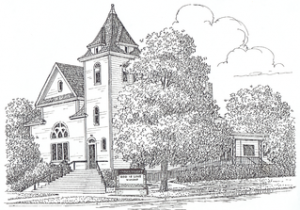In Peoria County, Illinois in the 1850s, many enslaved people escaping from their slaveholders stopped to seek shelter in Brimfield’s Congregational Church, which was under the ministry of “violent
abolitionist” J. E. Roy. According to Illinois historian Owen Muelder, one episode even involved “a party of 11 freedom seekers, who had fled from Palmyra, Missouri, carrying along “a crippled woman whom the others carried in a sheet, tied at the corners and suspended on a pole.”[1] If nothing else, this remarkable incident demonstrates the importance of looking beyond the state’s borders when examining the experiences of escaped Missouri slaves.
In The Underground Railroad in Western Illinois, Muelder, who is the director of Knox College’s Galesburg Colony Underground Railroad Freedom Center, presents a thorough overview of the major agents and activities of the Underground Railroad (UGRR) network in the “military tract” region of Western Illinois. Each chapter, organized based on the different counties of the region, is filled with stories quoted directly from original sources. In sharing these stories exactly as they were told from the voices of the abolitionist agents themselves, Muelder helps readers to “visualize more fully” the lives and stories of runaway slaves, many of which originated from Missouri, “in the late 1840s and 1850s in their valiant bid for freedom from bondage.”[2]
According to Muelder, everyone –including slaves, slaveholders, and abolitionists– was aware of the importance of the borderland between enslaved Eastern Missouri and Western Illinois. In fact, Illinois abolitionists frequently took advantage of this proximity, leading to the concentration of UGRR agents who were “eager to liberate slaves from across the river” in towns right along that border, such as in Quincy.[3] According to abolitionist Hiram Mars, Quincy abolitionists would even go as far as actually crossing the state line to seek out slaves and convince them to escape.[4]
Many of the abolitionists who risked traveling into Missouri to guide freedom seekers across the Mississippi River were themselves once escaped slaves. Throughout his text, Muelder makes reference to the ubiquitous figure of “Charlie,” an escaped Missouri slave who spent his whole life traveling in and out of slave states along the UGRR. According to numerous sources presented by Muelder, Charlie helped Missouri slaves escape along the UGRR to the Illinois counties of Plymouth, McDonough, Knox, and Stark.[5] Little is known of Charlie’s actual life and most of what is known is impossible to corroborate, but the popular narrative is that after Charlie escaped his enslavement, he returned to seek out and rescue his wife only to find that she had already been sold away. Charlie then spent years helping countless other enslaved families escape, perhaps always still searching for his wife.[6] It is possible that this story has been romanticized over the years, but nonetheless it underscores the important role that previously escaped slaves often played on the UGRR.
Charlie was certainly not alone. Chapman’s History of Knox County, Illinois describes an 1858 stampede in which “a colored man was taken through [Galesburg] to Canada, who shortly afterward found his way back to Missouri and started with nine other slaves for the land of freedom, but reached Galesburg with only five or six. With these it is presumed he got safely through to Canada.”[7] This important fact about the nature of slave stampedes, that some of them may have been initiated and led by former slaves still in hiding, emphasizes a critical aspect of the network that was essential to enabling larger group escapes.
[1] Owen Muelder, The Underground Railroad in Western Illinois (Jefferson, NC: McFarland & Co., 2008), 93.
[2] Galin Berrier, “The Underground Railroad in Western Illinois,” Annals of Iowa 67:2 (2008): 225.
[3] Muelder, 35.
[4] Muelder, 8.
[5] Muelder, 55-56, 69-71, 112, 136.
[6] Muelder, 136.
[7] Muelder, 110-111.

